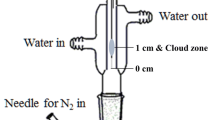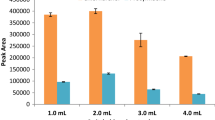Abstract
Pyrazine compounds in Chinese liquors are one of the most important factors that affect the flavor. However, only limited information is available regarding pyrazine compounds in Chinese liquors. An analytical method for pyrazine compounds (9 pyrazines) was developed using head space solid phase microextraction (HS-SMPE) and gas chromatography with nitrogen-phosphorus detection (GC-NPD). Pyrazine compounds in different types of Chinese liquors collected from different plants were also evaluated and compared by the methods devised in this study. The linearity and recovery with this method were satisfactory in all test cases. Quantitative results revealed that concentrations of 7 pyrazines were higher in the liquors from King’s Luck than from other plants. Further research is needed on the mechanism responsible for high concentrations of pyrazine compounds in Chinese liquors.
Similar content being viewed by others
References
Swiegers J, Bartowsky EJ, Henschke P, Pretorius IS. Yeast and bacterial modulation of wine aroma and flavour. Aust. J. Grape. Wine. R. 11: 139–173 (2005)
Liao Y-H, Yang Ch-X, Hu J-Y. Comparison of aroma compounds in mild aromatic Niulanshan, erguotou liquor and strong aromatic Niulanshan liquor by GC-MS. Food Sci. 33: 181–185. (2012)
Minussi RC, Rossi M, Bologna L, Cordi L, Rotilio D, Pastore GM, Durán N. Phenolic compounds and total antioxidant potential of commercial wines. Food Chem. 82: 409–416 (2003)
Paixão N, Perestrelo R, Marques JC, Câmara JS. Relationship between antioxidant capacity and total phenolic content of red, rosé and white wines. Food Chem. 105: 204–214 (2007)
Higasio YS, Shoji T. Heterocyclic compounds such as pyrroles, pyridines, pyrollidins, piperdines, indoles, imidazol, and pyrazins. Appl. Catal. A-Gen. 221: 197–207 (2001)
Maga JA, Katz I. Pyrazines in foods: An update. Crit. Rev. Food. Sci. 16: 1–48 (1982)
Jianping C. Pyrazines as important heterocyclic flavors special. Petrochem. 4: 44–47 (1994)
Liao SL, Kao TK, Chen WY, Lin YS, Chen SY, Raung SL, Wu CW, Lu HC, Chen CJ. Tetramethylpyrazine reduces ischemic brain injury in rats. Neurosci. Lett. 372: 40–45 (2004)
Ho W, Wen H, Lee C. Tetramethylpyrazine for treatment of experimentally induced stroke in Mongolian gerbils. Stroke 20: 96–99 (1989)
Tsai TH, Liang CC. Pharmacokinetics of tetramethylpyrazine in rat blood and brain using microdialysis. Int. J. Pharmaceut. 216: 61–66 (2001)
Fan W, Xu Y, Zhang Y. Characterization of pyrazines in some Chinese liquors and their approximate concentrations. J. Agr. Food Chem. 55: 9956–9962 (2007)
Lojzova L, Riddellova K, Hajslova J, Zrostlikova J, Schurek J, Cajka T. Alternative GC-MS approaches in the analysis of substituted pyrazines and other volatile aromatic compounds formed during Maillard reaction in potato chips. Anal. Chim. Acta 641: 101–109 (2009)
Wang L, Wu J, Lei L. Fast detection of four pyrazines in Chinese liquor by GC-MS/SIM. Chin. Brew. 204: 148–150 (2009)
Alberts P, Stander MA, Paul SO, de Villiers A. Survey of 3-alkyl-2-methoxypyrazine content of South African sauvignon blanc wines using a novel LCAPCI-MS/MS Method. J. Agr. Food Chem. 57: 9347–9355 (2009)
Li J, Wang D. Determination of nitrogenous compound in liquor by SPME-GC-MS-SIM. Liquor-Making. Sci. Technol. 195: 89–92 (2010)
Galvan TL, Kells S, Hutchison WD. Determination of 3-alkyl-2-methoxypyrazines in lady beetle-infested wine by solid-phase microextraction headspace sampling. J. Agr. Food Chem. 56: 1065–1071 (2008)
Wardencki W, Sowinski P, Curylo J. Evaluation of headspace solidphase microextraction for the analysis of volatile carbonyl compounds in spirits and alcoholic beverages. J. Chromatogr. A 984: 89–96 (2003)
Sala C, Mestres M, Martı M, Busto O, Guasch J. Headspace solidphase microextraction method for determining 3-alkyl-2-methoxypyrazines in musts by means of polydimethylsiloxane-divinylbenzene fibres. J. Chromatogr. A 880: 93–99 (2000)
Sala C, Mestres M, Martý M, Busto O, Guasch J. Headspace solidphase microextraction analysis of 3-alkyl-2-methoxypyrazines in wines. J. Chromatogr. A 953: 1–6 (2002)
Müller R, Rappert S. Pyrazines: occurrence, formation and biodegradation. Appl. Microbiol. Biotechnol. 85: 1315–1320 (2010)
Sala C, Busto O, Guascha J, Zamora F. Factors affecting the presence of 3-alkyl-2-methoxypyrazines in grapes and wines: A review. Available from: http://www.tdx.cat/bitstream/handle/10803/8653/15-PaperC2.pdf?sequence=15. Accessed 2012.
Buttery RG, Orts WJ, Takeoka GR, Nam Y. Volatile flavor components of rice cakes. J. Agr. Food Chem. 47: 4353–4356 (1999)
Oh YC, Hartman TG, Ho CT. Volatile compounds generated from the Maillard reaction of Pro-Gly, Gly-Pro, and a mixture of glycine and proline with glucose. J. Agr. Food Chem. 40: 1878–1880 (1992)
Wagner R, Czerny M, Bielohradsky J, Grosch W. Structure-odouractivity relationships of alkylpyrazines. Z. Lebensm-Wiss. Technol. 208: 308–316 (1999)
Mihara S, Masuda H. Structure-odor relationships for disubstituted pyrazines. J. Agr. Food Chem. 36: 1242–1247 (1988)
Fan W, Qian MC. Characterization of aroma compounds of Chinese “Wuliangye” and “Jiannanchun” liquors by aroma extract dilution analysis. J. Agr. Food Chem. 54: 2695–2704 (2006)
Qian M, Reineccius G. Static headspace and aroma extract dilution analysis of Parmigiano Reggiano cheese. J. Food Sci. 68: 794–798 (2003)
Counet C, Callemien D, Ouwerx C, Collin S. Use of gas chromatography-olfactometry to identify key odorant compounds in dark chocolate. Comparison of samples before and after conching. J. Agr. Food Chem. 50: 2385–2391 (2002)
Author information
Authors and Affiliations
Corresponding author
Rights and permissions
About this article
Cite this article
Wu, JF., Xu, Y. Comparison of pyrazine compounds in seven Chinese liquors using headspace solid-phase micro-extraction and GC-nitrogen phosphourus detection. Food Sci Biotechnol 22, 1–6 (2013). https://doi.org/10.1007/s10068-013-0209-3
Received:
Revised:
Accepted:
Published:
Issue Date:
DOI: https://doi.org/10.1007/s10068-013-0209-3




